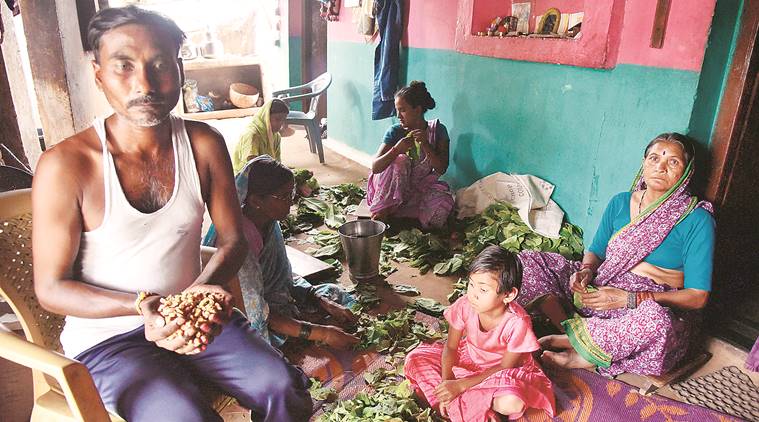
By the lakeside, in a patch of forest near Tukum village, a drama plays out daily — a pick-up vehicle wheels in noisily and brakes to a halt. The men in the vehicle jump out and hurriedly wade into the lake to lay their fishing traps and recede quickly under the scorching Chandrapur sun.
The men, it seems, know they do not have much time. Less than 50 metres away, in the cool shade of a grove of trees, a sub-adult female tiger lurks, biding time to enter the lake. The tigress is one of three animals that have struck fear in the hearts of people in the dozen-odd villages in Brahmapuri division of the territorial forest.
This morning, the fishermen seem both resigned to how close they are to a big cat as well as conscious of the threat from it. And that is how it is for the hundreds of families living in these villages since the past few months, as they balance their need to eke a living with their fear of being attacked by a tiger.
According to figures made available by Brahmapuri Deputy Conservator of Forest, Kulraj Singh, in 2018-19, the division saw 14 people killed in human-wildlife conflict — seven by tiger, four by leopard and three in wild boar attacks. The numbers have risen from six in 2016-17 and nine in 2017-18.
Since January this year, six people have been killed by tigers, five of them in the troubled area around Mendhki village in the North Brahmapuri forest range. It is one of the five ranges of the Brahmhapuri division, which has earned the reputation of being the best conservation model outside protected areas (Pas), such as tiger reserves and wildlife sanctuaries.
Spread over 986 sq km, the division has over 610 villages, about half of them in forested patches. Official estimates put the number of tigers in the region at more than 40. The neighbouring Tadoba-Andhari Tiger Reserve (TATR) is a source for the Brahmapuri tigers. While the number of tigers increased due to the efforts of the department, the man-animal conflict was the writing on the wall that a few saw.
On January 12, cowherd Diwakar Gedam, 55, from Halda, was killed by a tiger when he was in the forest.
On February 16, a Padmapur villager, Anita Gedam, 40, was working in her farm along with other women when a tiger killed her. Between late March and May, villagers cannot stay away from the forests as it is the season for Mahua flowers and tendu leaves — the produce fetch each family around Rs 30,000. Paddy farming, which many of them are also engaged in, yields too little to count.
On March 27, Jankiram Bhalavi, 50, from Rampuri village, had gone to the forest to collect mahua flowers at 7 am along with wife Anusuya. “That was the sixth day of mahua collection. We were collecting the flowers very close to each other and after every basketful, we used to dump it near a bicycle parked in the middle. Around 8 am, when I emptied my basket, I just called out for him. He didn’t reply. I called the other people collecting mahua nearby to search for him. Later, I found him lying dead in the forest with the tiger lurking,” Anusuya said.
A few days later, on April 6, Anusuyabai Bankar, 60, from Navegaon village, was also collecting mahua along with her sister Baby Shende, when a tiger caught her by the neck.
On April 17, when Pratibha Gavture, 35, from Mendhki village, had gone to collect mahua along with some other villagers, she was mauled to death by a tiger.
Maharashtra offers one of the highest compensations in the country for deaths, injuries and crop damage by wildlife. The Forest Department pays Rs 15 lakh to each family, Rs 3 lakh by cheque and Rs 12 lakh in a joint account with the Additional Collector of Chandrapur, to such victims. The interest of that amount goes to the next of kin until death.
While all victims’ families have got their compensation cheques, they await for a word on the joint account. DCF Kulraj Singh said the process has been initiated and would be completed soon.
Apart from financial aid, the department also employs one member from every family as a forest labourer on a daily wage at the prevailing rate of Rs 320 per day.
People still venture into the forest since they can’t forfeit their tendu claim. “Jawaa nahi ta kaa khawaa (if we won’t go what shall we eat),” Anita Gedam’s mother-in-law Bhagwatabai said.
Villagers also are dependent on the forest for firewood. The Pradhanmantri Ujjwala Yojana to provide LPG connections has hardly met their need for cooking fuel. “We don’t have money to buy cylinders. And they don’t deliver here. Even if we buy, we have to cart it from the LPG agency’s office because they don’t deliver,” villagers say.